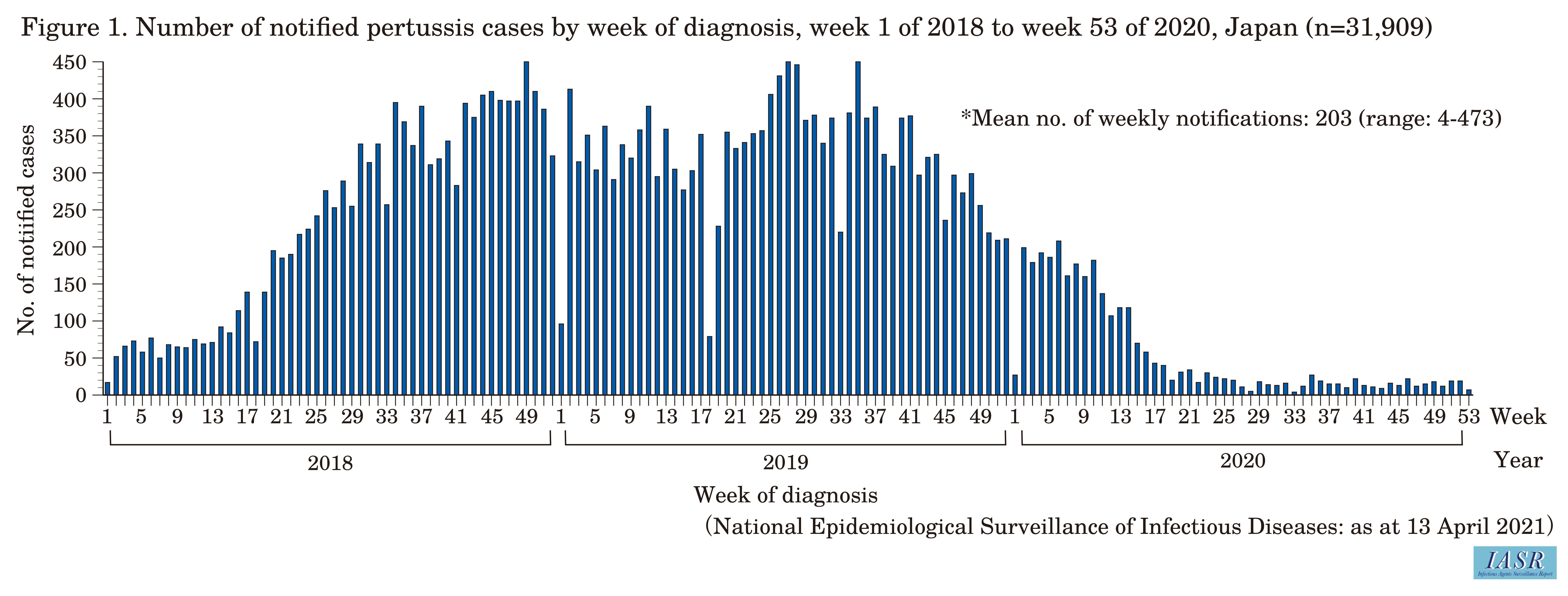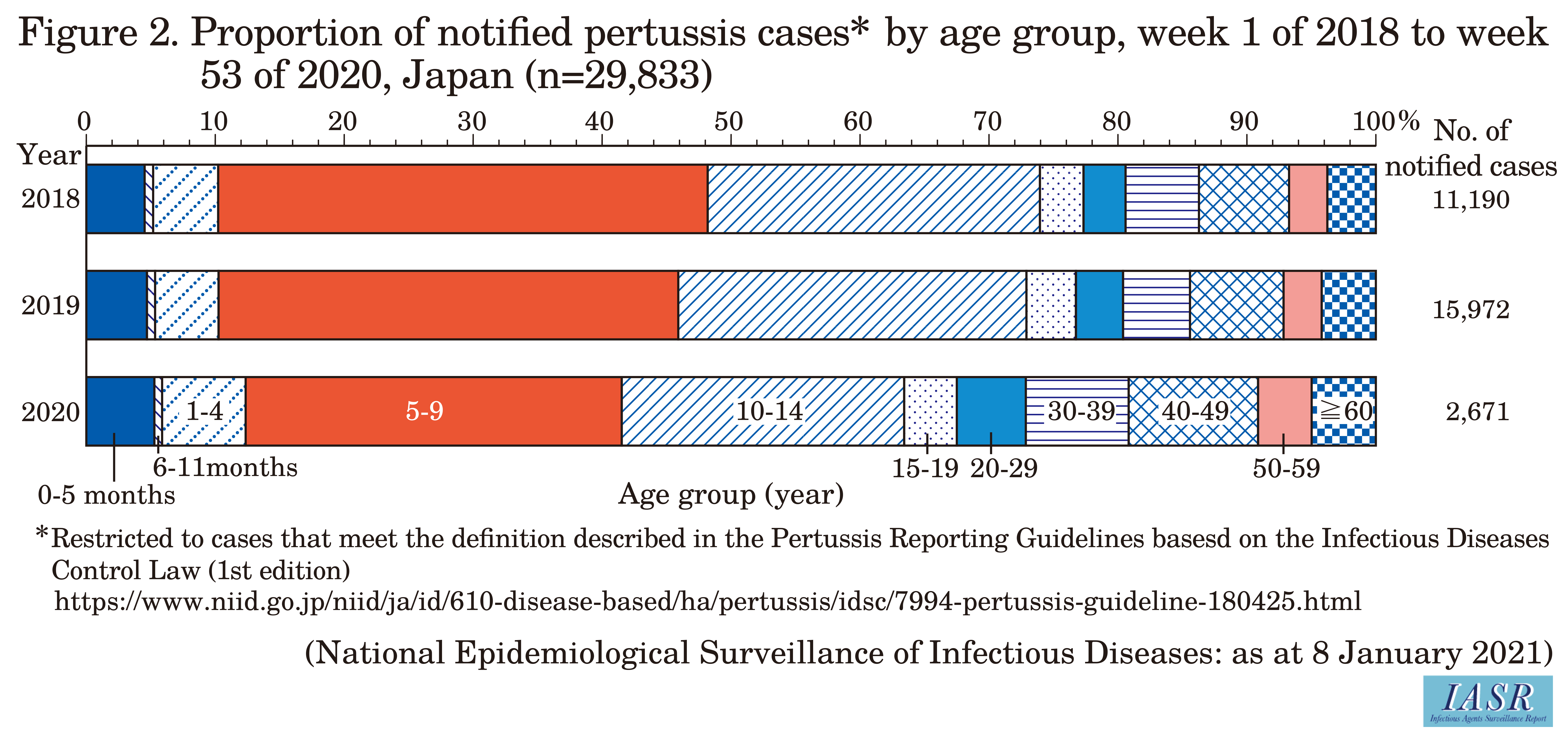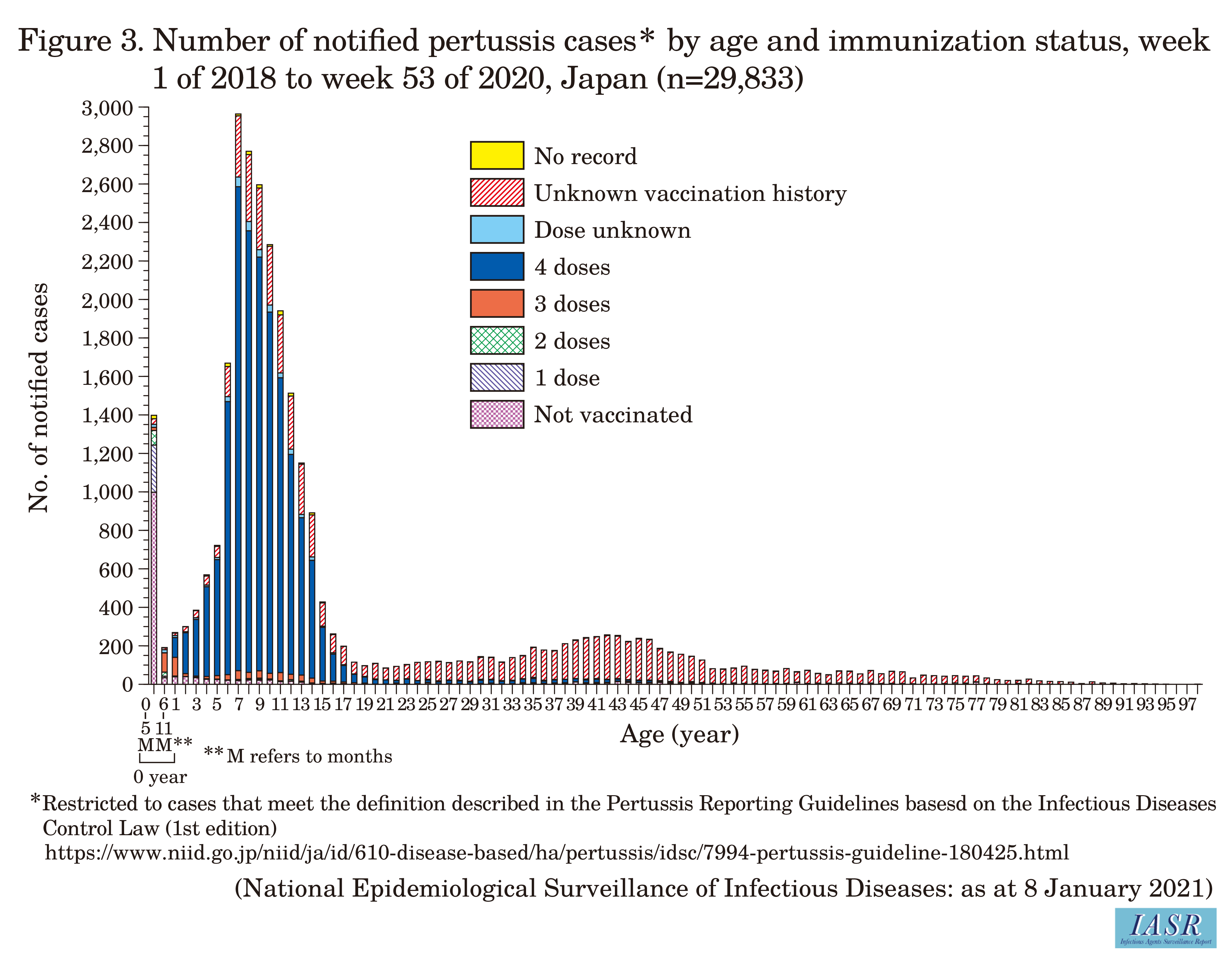IASR 42(6), 2021【THE TOPIC OF THIS MONTH】Pertussis in Japan, as at January 2021
![]()
The topic of This Month Vol.42 No.6(No. 496)
Pertussis in Japan, as at January 2021
(IASR Vol. 42 p109-110: June 2021)
Pertussis is defined as an “acute respiratory tract infection caused by Bordetella pertussis (B. pertussis) ” in the reporting criteria for physicians under the Infectious Diseases Control Law. The main symptom is prolonged coughing and the severity is greater in infected newborns or infants. In Japan, the “adsorbed diphtheria-purified pertussis-tetanus combined (DPT) vaccine” has been used in routine immunization, but in November 2012, DPT-IPV, consisting of DPT and inactivated polio combined vaccine (IPV), was introduced as a routine immunization. According to the immunization schedule for DPT-IPV in Japan, for the primary series, three subcutaneous injections are administered (usually for those 3-12 months of age) with an interval of at least 20 days between each dose (the standard interval is 20-56 days). For the booster dose, after the initial dose a subcutaneous injection is administered at least 6 months after three doses of the primary series (the standard interval is 12-18 months after completion of three doses of the primary series). Immunity acquired by vaccination wanes in 3-4 years, and those previously vaccinated may also become infected and develop the disease. In developed countries, adolescents and adults being a source of infection, transmitting the disease to their families and unvaccinated children, sometimes resulting in severe illness, is of concern (see pp. 111&112 of this issue). As one of the measures to protect infants from pertussis, some countries recommend vaccination of adolescents and adults, including pregnant women, with a reduced quantity of pertussis and diphtheria antigens in DPT (Tdap; not approved in Japan) (IASR 40: 14-15, 2019). In Japan, DPT can be vaccinated on a voluntary basis instead of Tdap.Since January 1, 2018, pertussis has been a category V notifiable infectious disease under the Infectious Diseases Control Law (IASR 39: 13-14, 2018). As a result, pertussis cases notified to the National Epidemiological Surveillance of Infectious Diseases (NESID) are those with the clinical presentation of pertussis and, in principle, those confirmed by laboratory diagnosis (https://www.mhlw.go.jp/bunya/kenkou/kekkaku-kansenshou11/01-05-23.html).
Laboratory diagnosis of pertussis
For the laboratory diagnosis of pertussis, bacterial isolation, serological tests, and bacterial gene detection are available (IASR 38: 33-34, 2017). Bacterial isolation has high specificity but requires a special culture medium. In addition, the detection rate is low, at less than 60% even for infants who have relatively high levels of the bacteria in the respiratory tract during the course of infection. It is more diff icult to isolate the bacteria from those previously vaccinated and from adults and adolescents who have low levels of bacteria. Serological diagnosis using anti-PT IgG is used globally, but the World Health Organization (WHO) does not recommend its use for infants whose immune system is immature or for those who were vaccinated within one year. In Japan, serodiagnostic tests that detect IgM and IgA antibodies against B. pertussis were approved in 2016 and are covered by Health insurance. Bacterial gene detection has the highest sensitivity and the real-time PCR method is used globally. In Japan, the loop-mediated isothermal amplification method to detect B. pertussis was developed as a highly specific test, enabling a faster and simpler diagnosis than real-time PCR, and has been covered by Health insurance since November 2016. The recommended laboratory test method for pertussis depends on the time from the onset of symptoms, and it is important to select an appropriate diagnostic method for an accurate diagnosis.Pertussis notifications under the NESID system
Trends in the number of cases reported weekly in Japan from 2018 to 2020 are presented (Fig. 1). There were 31,909 cases notified to NESID during the three years from 2018 to 2020 when notifications of all cases began. In 2018, the number of notified cases started to increase around week 16, and the cumulative number of notifications reached 12,116 for the year. In the following year, 16,846 cases were reported, but in 2020, when the COVID-19 pandemic occurred, only 2,947 cases were reported (see p. 113 of this issue).
The median age of the notified cases from January 2018 to 2020 was 10 years (range 0-98), with patients aged 5-9 years representing 36% of the total, followed by those aged 10-14 years (26%). Patients younger than one year of age accounted for approximately 5% of the total (Fig. 2). There were many patients aged 6 to 13 years, an age group corresponding to elementary and junior high school students (Fig. 3). The number of patients under 6 months of age who are prone to severe disease when infected with pertussis was 1,398 cases (4.7%). Moreover, there were pertussis patients in the adult population, whose number was hitherto unclear from pediatric sentinel surveillance, with many being in their late 30s to 40s.


Of the notified pertussis cases, 29,833 cases met the notification guidelines, 57% (17,062 cases) had four doses of a pertussis-containing vaccine, and 73% (16,646/22,822 cases) of those aged 20 years or younger and 80% (15,243/18,929 cases) of those aged 5 to 15 years had been vaccinated, revealing that most pediatric patients were those previously vaccinated (Fig. 3). These proportions have changed little since 2018.
Outbreaks
In 2007, Japan experienced multiple outbreaks of pertussis in universities, suspected to have involved more than 200 cases (IASR 29: 70-71, 2008). In recent years, reports of pertussis outbreaks have included those that began in primary and junior high schools that led to an increase in pertussis in the local community (IASR 38: 25-26 & 26-28, 2017) and outbreaks in urban settings (IASR 40: 7-9 & 10-12, 2019). As pertussis is now a notifiable disease with reporting of more detailed patient information, earlier outbreak detection and response are expected.Pertussis Seroprevalence in the Japanese population
According to the 2018 seroprevalence survey, i.e., National Epidemiological Surveillance of Vaccine-Preventable Diseases (NESVPD), the proportion positive for anti-pertussis toxin (PT) IgG antibody was 80% among those 6-11 months of age (https://www.niid.go.jp/niid/ja/y-graphs/8815-pertussis-yosoku-year2018.html). Seroprevalence decreased with age, reaching the lowest level among 7-12-year-olds, but subsequently increased with age. There is no additional pertussis vaccination in Japan after 90 months (7.5 years) of age, suggesting the possibility of natural infection in school-age children. In addition, the decrease in seroprevalence among 4-7-year-olds confirmed in the previous survey (2013) shifted over time to 7-12-year-olds, suggesting that vaccine effectiveness was lower in this group, but the cause of this change is unknown.Pathogenic agents of pertussis and molecular epidemiology
As for B. pertussis, in recent years, MT27 strains, which are strains circulating in Europe and the United States, have been increasing in Japan (IASR 40: 3-4, 2019), but due to the widespread use of gene detection tests and the decrease in bacterial culture tests, the number of clinical isolates obtained has decreased, making it diff icult to determine the epidemic strains. Macrolide antimicrobial agents are the first choice for treatment. However, in recent years, macrolide-resistant strains in Asia continue to be reported (see p. 115 of this issue). Macrolide-resistant B.pertussis has also been clinically isolated in Japan (see p. 116 of this issue), and it is important to continue to collect clinical isolates and to monitor for resistant strains. Bordetella species, such as Bordetella parapertussis and Bordetella holmesii, also cause symptoms similar to those of pertussis, but case reports of infection with these species are rare in Japan.Conclusion: Due to the introduction of all-case notifications to NESID for pertussis since January 1, 2018, more detailed epidemiological information, such as symptoms among those younger than 6 months of age, the number of cases among adults, and vaccination history, has become available. It is hoped that this information will lead to the early detection of and response to pertussis outbreaks, along with assessment and implementation of effective prevention and response measures.

